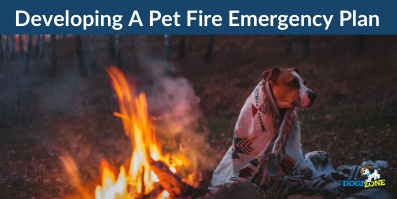Developing A Pet Fire Emergency Plan
Everyone should have a fire emergency plan designed for their home. This plan needs to include where and how to leave the residence based on fire starting or spreading to different areas of the home. 
While most families have a general understanding of where to go and how to get out of the house if there is a fire, most family fire emergency plans do not consider dogs and other pets.
Unfortunately, when there is a fire, dogs and other animals in the house often become confused and terrified. They may hide under beds or behind furniture and fail to leave the home with the family. Dogs and cats may also leave the house but panic and run into the street, or run for miles before calming and slowing down.
In the United States, approximately half a million pets are involved in house fires every year. The National Fire Protection Association estimates as many as 1000 house fires in the United States are started by pets. This is most commonly by knocking over burning candles or jumping up on stoves and turning on burners that are left at high heat for extended periods of time.
Another cause of fires can be glass water bowls left outside on wood decks. When the sun hits the bowl, it can turn into a magnifying glass, igniting the wood to the side of the bowl and resulting in a fire.
To help plan for a fire emergency, here are a few key factors to keep in mind:
- Crate training a dog – having a dog in a crate at night or when you are away helping to locate the pet in an emergency. Keep a collar and a leash near the crate at all times in the event you have to leave the house due to fire.
- Identify pets in the house – make sure if pets are in the house emergency services have this information. Window signs and pet alert window cling decals should be placed at all doors to the house. List the number of pets and the species of the pets on the sign, and make sure it is legible. Provide information on where they are in the home, and place a decal in the window of that room as well.
- Keep pets in main areas of the home when away – keep pets out of back rooms and basements if you are away. By having the pet in a main area of the house the emergency responders are more likely to see the pet and make the rescue.
- Designated responsibility – have one person responsible for each pet in the house. This individual should be an adult as children can also panic and become confused or frightened in an emergency situation. When children know Mom or Dad is going to get the pet, they are much less likely to stay in a potentially life-threatening situation.
- Fire safety practices in the house – if you have a stove with front burner controls, purchase burner knob covers that prevent accidental turning on of the stove. Make sure all candles are extinguished when you leave the room, or make the switch to LED candles for increased safety. Never leave pets in the kitchen unattended with food cooking on the stove or when electrical cooking appliances are in use.
Talk to the family and work together to make the house safe for your dog. Have a plan to get the pets out of the house, and be sure to discuss this with other family members on an annual basis.

